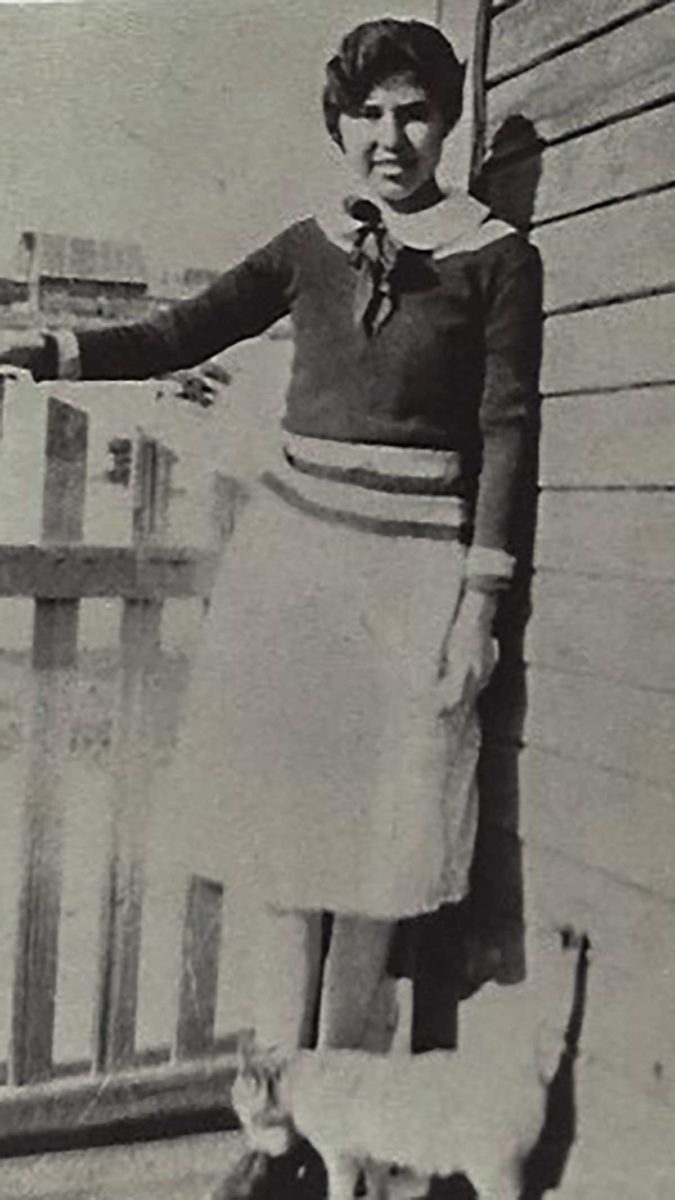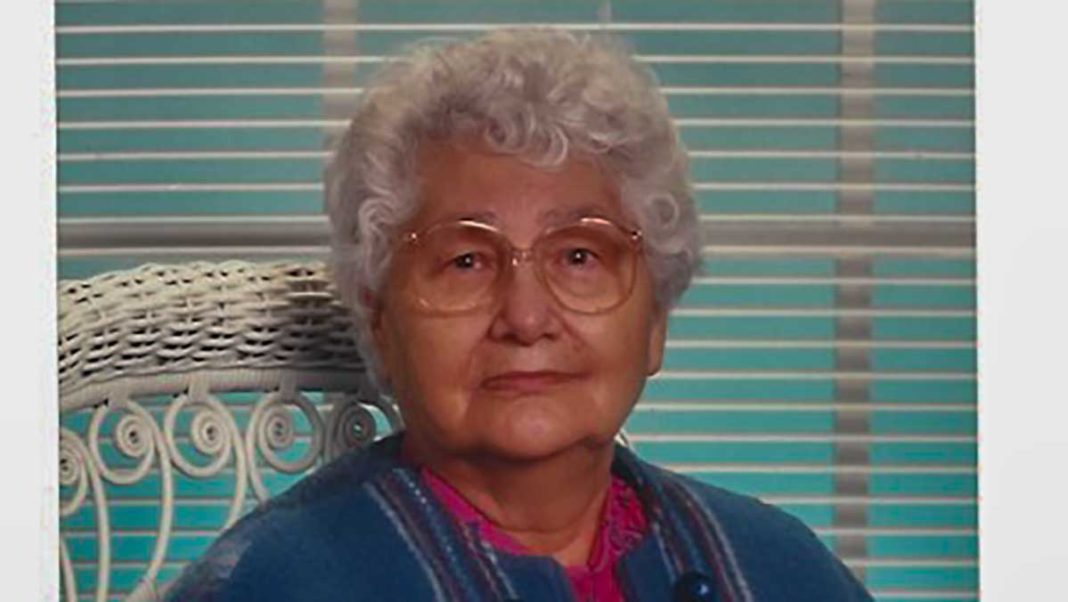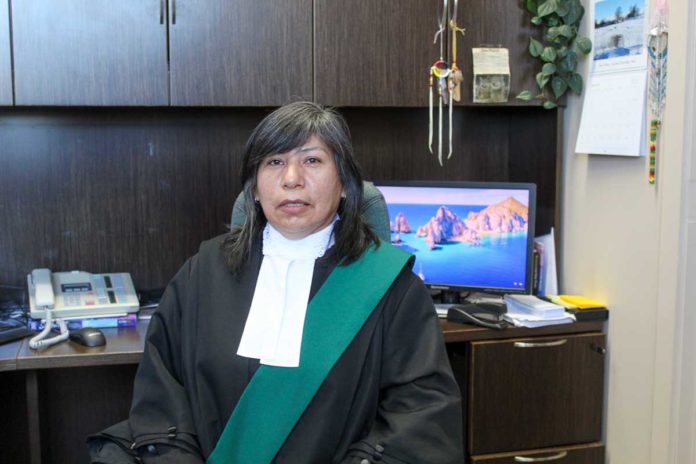EDITOR’S NOTE: Barbara Vibbert of Washington reached out to The Expositor in the 1990s seeking information on her mother, residential school survivor Margaret Ann Rita Garbow’s, family. The result was an emotional reconnection that took place at the Wiikwemkoong Powwow. Ms. Steeves has since written the story of her mother’s experiences and life which she has provided to The Expositor for publication and is provided below.
by Barbara Vibbert
‘Dreams flash across the minds of many, terrifying, satisfying, unrelenting, but dreams pass and we find peace at last’ by Evelyn Smith (Buswa) 1961, from the inscription on the memorial to indigenous children who were at the Residential School in Spanish, Ontario.
Margaret Ann Rita (Gabow), otherwise known to friends and family as Mrs. Steeves, Marge or Mum, was born May 30, 1914 on Wikwemikong Unceded Indian Territory, home of the Three Fires, Manitoulin Island, Ontario. She was baptized Marguerite Gabow Wassegijig, the eldest of 10 Odawa children born to Ignatius Wassegijig and Eliza Corbiere Wassegijig on May 31, 1914.
About age 5, by Canadian law, Marguerite was separated from her home and family to attend a federally funded residential school. These schools were set up for Canadian aboriginals who did not have an Indian Day School located within five kilometres of their home and were usually owned and operated by the Roman Catholic Church, Anglican, Presbyterian or United Churches. One hundred and thirty-two federally supported schools were located in every province and territory, except Newfoundland, New Brunswick and Prince Edward Island. The primary objectives of the residential school system were “to remove and isolate children from the influence of their homes, families, traditions and cultures, and to assimilate them into the dominant culture” as quoted by Prime Minister Harper in his 2008 Statement of Apology to Former Students of Indian Residential Schools.
Marguerite was sent to the St. Joseph’s School for Girls (also known as the Spanish Indian Residential School for Girls), operated by the Daughters of the Heart of Mary, situated off-island in Spanish, Ontario, where her given name was changed to Margaret. Her younger sisters also attended the school. One died there, the fate of many indigenous children who were taken from their homes.
With well-intentioned goals of preparing the children to live in a “white man’s world,” the schools focused on morals, academics and industrial training. However, conditions were harsh and often counterproductive. Students were forbidden to speak their own language, practice their own culture, or keep their family name. They had their hair cut short, wore uniforms, had regimented days, frequently suffered malnutrition, neglect, cold, and sometimes abuse. Numbers replaced names as the nuns sought to “kill the Indian in the child.” They were forced to learn English. Failure to comply with the rules meant punishment by strapping. Wetting the bed meant being made to stand for hours covered in a cold, urine-soaked sheet. The Canadian government paid the residential schools at Spanish a bare minimum–35 cents a day or $129.31 a year per child. The poor funding meant the schools had to be self-sustaining. Therefore, classes were held for half a day then students were required to work the rest of the day. They cooked, cleaned, did laundry, grew their own food, made their own clothes and farmed to earn their keep. The girls at St. Joseph’s were taught the “Domestic Sciences” in addition to English and Mathematics, as the Sisters prepared them to obtain jobs “as domestics among white people.” They learned sewing, knitting, cooking, dressmaking and the Roman Catholic catechism.
The St. Joseph’s School for Girls opened in 1913, closed in 1962, and burned in 1981. The burned empty shell of the building that now stands is a stark reminder of a well-meaning policy gone tragically wrong.
Some of these children died at the schools or never returned home. Others went on to learn from their experience and lead productive lives both on and off the reserves. If total assimilation into Canadian society was the government’s goal, then Margaret was the perfect example.
She thrived on her studies, helped care for the younger children at St. Joseph’s, and became an accomplished “domestic artist.” At age 18 Margaret was “farmed out” to work in a “guest home” in Espanola and was subsequently sent 2,000 km away to Saint John, New Brunswick to be a caregiver for the invalid wife of a judge. She had no contact with her family who was told she had died.

The school, however, did not erase her spirit or her indomitable will to survive. Margaret set to work applying her special skills and personality to building a life. The petite, 5 ft. 2 in. brown eyed, dark-haired beauty met a tall, blonde, handsome soldier from Albert County at a dance in St. John. In 1940, she married that soldier, Hilburn Wallace Steeves, aka “Hilly,” “Wallace John” or “Boots” and moved to the German-English Protestant community of Surrey in Albert County where Hilly had been raised on the Steeves family farm. Her life became busier with three children, a girl and two boys in just over three years; a move to the United States in April 1946, to Maine, then New Hampshire, then Massachusetts, and the birth of a daughter before returning to Surrey in 1947; and then, four more children completed her brood of eight. Life with Hilly wasn’t easy. New Brunswick has been one of the poorest provinces in Canada since the 1900s. Work was scarce in Albert County. Hilly’s only options to make a living were logging or farming so he was often out of work or away from home for months at a time working in construction with his father in the US. His penchant for alcohol eventually left the family in dire straits. A fire in their home in 1955 forced a move to an old farmhouse on 20 acres in Demoiselle Creek, Albert County. Despite many hardships, Margaret and her children were happy there. After 24 years of marriage and a yearlong battle with cancer, Hilly died, leaving Margaret with six children under the age of 18, the two eldest having moved on to the Canadian Armed Forces and marriage.
Faith in God and her own abilities gave Margaret the strength and courage she needed to carry on. The vagaries of her married life and residential school did not quell her spirit, neither did life’s ups and downs. She was a dedicated homemaker, able to provide for her family by taking in sewing, along with help from her husband’s family, friends and the Canada Child Benefit income—$80 a month. Margaret was a vibrant force in the community, caring for neighbours, attending church and actively participating at the Albert Mines Senior Citizens Community Center. As a member of the Progressive Conservative Party, she often helped at voting polls and developed a life-long interest in politics. She was an officer in the Hillsborough Branch No. 32 Royal Canadian Legion Ladies Auxiliary and played on the dart team. Margaret could always be counted on to volunteer whenever the need arose.
Mostly, though, she is remembered by her family for the values she instilled in them. She taught them the virtues of responsibility and hard work. They all had household chores and were taught how to cook, clean and even to knit. They learned how to hunt, trap and fish. Every Spring the family gathered samphire and goose tongue greens from the marshes of the Petitcodiac River and fiddleheads from the brooks of Demoiselle Creek. In Summer they tended the garden and picked wild berries to can. Late summer and fall was for preparing for winter – harvesting, canning and piling in wood. There were always loads of firewood in the yard needing to be stacked away. Times were hard but manageable. Margaret made sure her family was kept warmly clothed and fed. She brought love, laughter and imagination into her children’s lives. The house was always jumping with activity as the holidays and social occasions demanded full participation. Steeves Family reunions were particularly raucous with relatives coming from all over. They even celebrated Christmas in July!
If anything defined Margaret, it was her devotion to family and service to others. Each child was taught to look after one another and to help others whenever they could. As adults, they remain a very close family who connect routinely through social media and frequent phone calls. Margaret demonstrated that service to others is a big part of what life is about. She sewed clothes for Red Cross distribution for which she was honored. She worked for a time at a nursing home in Hillsborough. When it closed, she brought some of the residents to her own home so they would have a home where they would be cared for till the end of their days.
Margaret’s life before marriage to their father had always been a mystery to her children but after 15 years of searching for clues, her eldest daughter, Barbara, finally was able to obtain her mother’s birth records. In February 1991, Barbara wrote a letter to the editor of The Manitoulin Expositor in Little Current on Manitoulin Island asking if there were any records to which they might have access regarding her mother. The letter was forwarded to the Holy Cross Mission in Wiikwemkoong, and word came back of a female born on 30 May 1914 – a Marguerite (Wassegijig) Gabow. Barbara learned she had aunts, uncles and many cousins living on Manitoulin Island. The aunties invited Margaret and all her family to meet them. Eight members of Margaret’s family travelled to Manitoulin Island in August 1991 for a reunion with her aboriginal family. Her sisters had never given up hope that Margeurite was alive and well. The aunties welcomed her children into the family at the “Wikki” Pow-wow with a gift exchange and promenade around the sacred circle. Margaret’s sisters, Nora, Stella, Josephine and Georgina travelled to Demoiselle Creek to visit her in the Spring of 1992. At first Margaret wanted to lock them out of the house, but was convinced to meet them. While she never completely forgot her First Nations language, birth name, or her siblings, she was ashamed of her heritage and did not speak of this or her early childhood to her children or anyone else.
As the years passed and her last child left home in 1980, a lifetime of struggle and deprivation finally took its toll. In the early 1990s, depression and signs of dementia claimed her mind and independence. As dementia morphed into Alzheimer’s disease, she forgot the names of her children but often recalled episodes from her far past–remnants, sometimes traumatic, of her heritage. Margaret spent her final 13 years at Forest Dale Nursing Home, in Riverside-Albert, New Brunswick. Here she is remembered as a quiet, pleasant, agreeable person, who caused no one any problems – except when she “escaped” to “go home.” She adapted to institutional life yet again, making herself useful by helping other patients get around. Margaret died there on January 25, 2005, and is buried beside Hilly in Grey’s Island Cemetery, Hillsborough, New Brunswick. She was 90.
What of her offspring? They are fully registered members of Wikwemikong (now Wiikwemkoong). They and their families may be scattered from the Province of New Brunswick to Washington State but they’ve never forgotten their roots or the lessons their mother instilled in them. Their lessons in service to and for others is evidenced by their career choices.
Barbara, born 1941, now residing in Stanwood, Washington, served as a teletype operator in the Royal Canadian Air Force 1959 -1961 before marrying a US Air Force Sergeant/Army Warrant Officer from Washington State. She and her husband, Jim, who recently passed away after 60 years of marriage, lived and worked from Newfoundland to Alaska and across several states in the “Lower 48.” Her last job before retiring was grant writer and project manager for the Stillaguamish Tribe in Arlington, Washington.
William, born 1942, served in the Canadian Armed Forces 1961-1965 with a United Nations peacekeeping force in Cyprus and Germany. He drove big rigs from Ontario to British Columbia to the US for 25 years before retiring with his family in Ontario where he passed away in 2020.
David, born 1944, now residing in Albert Mines, New Brunswick with his wife, Ida, served in the US Army 1965-1968 as a medical corpsman in the US and Vietnam. He was a stationery engineer with the Downey Mill in Weldon until retirement.
Gloria, born 1946, currently residing in Virginia with her husband, George, served in the US Air Force 1966-1970 as a medical admin specialist in California and Germany. She is a retired US Treasury Agent.
Keith, born 1950, served in the Canadian Armed Forces 1969-1993 with NATO peacekeeping forces in Germany, Cyprus and Yugoslavia. He retired as an Army Warrant Officer after 25 years of service and now resides in Stoney Creek, New Brunswick with his wife, Giselle. Keith worked at The Rocks in Hopewell Hill as Manager of Park Interpretations and during the Winter Olympics of 2010 carried the Olympic torch on its relay to Vancouver, British Columbia. He is past president of The Royal Canadian Legion Branch No. 32 in Hillsborough where he continues volunteer service as Sergeant at Arms and Service Officer responsible for assisting area veterans.
Vickey, born 1952, operated Dutch Hill Bed and Breakfast with her husband in Sussex, New Brunswick before moving to their renovated farmhouse in Dawson Settlement where she lived until she passed away in 2019. She was active in the St. Mary’s Anglican Church, the Hillsborough Alumni Choir and the Close Harmony group of singers who performed at various fundraising functions for charity.
Paul, born 1953, serves as a pastor for Albert County churches and regularly ministers to disabled veterans at the Veterans Centre in Moncton. He holds online services from his home in Albert Mines, New Brunswick where he’s been a longtime resident with his wife, Colleen.
Melody, born 1955, served by working in a Salvation Army restaurant in 1977 in Germany. She and her husband, Charles, operated Spruce Hill Nursery in Bristol for 27 years. She recently retired in Bath, New Brunswick.
On September 19, 2007, the Canadian government implemented the Indian Residential Schools Settlement Agreement and subsequent Common Experience Payment Program to compensate residential school students for the egregious treatment they suffered under government policies for over a century.
On June 11, 2008, Canada’s then-prime minister, Stephen Harper, offered a full apology on behalf of Canadians for the Residential School System which began in 1870 as a way for the government to meet its obligations to educate aboriginal children. From 1870 to 1996 when the last residential school closed, Indian Residential schools separated over 150,000 aboriginal children from their families, their community and their heritage.
Margaret was one of those children. She overcame many different hardships, suffered every indignity with compassion and grace and kept her sense of humor. Though deprived of her birthright, she lived an authentic life of service for which her children and all who knew her can be grateful and proud. The Canadian government’s settlement and apology came too late for Marguerite Gabow Wassegijig – this Odawa woman and countless others.





